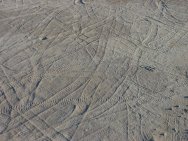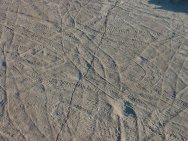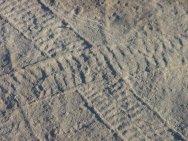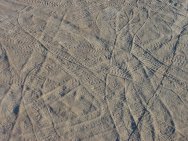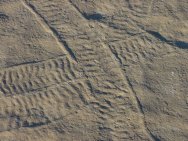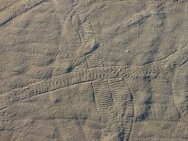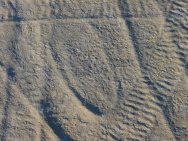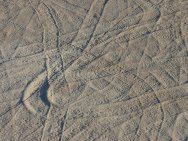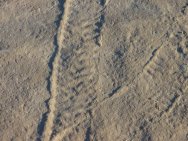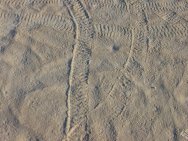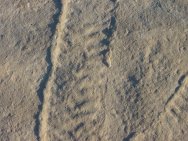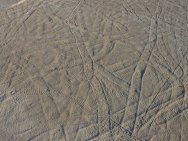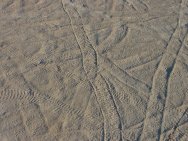Climactichnites wilsoni
The name Climactichnites is an Ichnogenus for the putative tracks (epifaunal trackways), not the name of the track makers life form
Geologic Time: Late Cambrian
Size: about 18 by 20 feet; thickness and tonnage undetermined
Fossil Site: Elk Mound Group, Outlier of the Mount Simon Limestone, Central Wisconsin
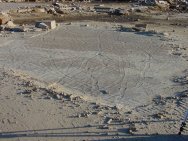 Never
heard of a Climactichnites,
well, join the club. Not many people have, despite its scientific description
in 1860 by Sir William
Logan. The pictures below show a huge portion of a bedding plane
absolutely loaded Climactichnites. When the photos were taken in 2004, this
was the floor of a portion of the working flagstone quarry. For perspective,
the fossil area measures about 18 by 20 feet. This ichnofossil normally
has two parallel ridges separated by chevron-shaped raised cross bars that
has often been described as motorcycle tracks; the ridges are sometimes
absent, or of varied prominence. The variable width is about four inches
on average. Some of are short, and some are many feet
long. Some are straight, and others are curved, or even sharply curved.
Never
heard of a Climactichnites,
well, join the club. Not many people have, despite its scientific description
in 1860 by Sir William
Logan. The pictures below show a huge portion of a bedding plane
absolutely loaded Climactichnites. When the photos were taken in 2004, this
was the floor of a portion of the working flagstone quarry. For perspective,
the fossil area measures about 18 by 20 feet. This ichnofossil normally
has two parallel ridges separated by chevron-shaped raised cross bars that
has often been described as motorcycle tracks; the ridges are sometimes
absent, or of varied prominence. The variable width is about four inches
on average. Some of are short, and some are many feet
long. Some are straight, and others are curved, or even sharply curved.
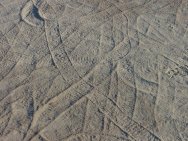
The fossil sites in Wisconsin and Canada where Climactichnites are found were tidal sandflats during upper Cambrian time. As such, the ichnofossils provide the oldest known evidence of animal terrestrial colonization of Earth in the fossil record -- the first footprints on land.
Some scientists
theorize that Climactichnites was made by an animal twice as long as wide
having a strongly muscled underside with oblique rows of cilia and lateral
flaps. The cilia may have been used to sort through sand for microorganisms
and its lateral wings to grip for locomotion. In the process of feeding,
sand was shoved into the conspicuous periodic 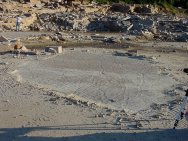 rows.
The flaps may also have been used for swimming. Since Climactichnites
is found on bedding surfaces with ripple marks and mud cracks, it probably
spent most of its life moving across the tidal sand flats that were at
least periodically above the water.
rows.
The flaps may also have been used for swimming. Since Climactichnites
is found on bedding surfaces with ripple marks and mud cracks, it probably
spent most of its life moving across the tidal sand flats that were at
least periodically above the water.
While long considered a Molusc trail (i.e., a large sea slug, or opisthobranchs), others have postulated it to be a body fossils of a large, strap-like floating zooplankter, which would help to explain how the tracks are often found to overlap in a manner that those above did not destroy those below during fossilization. Getty has recently postulated that what saved the tracks from destruction by wave action was a overlying microbial mats. Indeed, microbial sedimentary structures, such as domal sand buildups (i.e., sand stromatolites) are sometimes found in association with Climactinites in the quarry.
Climactichnites
remains enigmatic. Was it a slug making the first animal footprints on
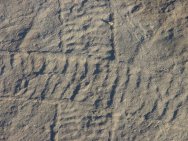 land
as it meandered in the surf munching on microbial mats? Or, was it a zooplankter
that floated ashore, and lured the maker of the Protichnites
arthropod trackways onshore to munch on it.
land
as it meandered in the surf munching on microbial mats? Or, was it a zooplankter
that floated ashore, and lured the maker of the Protichnites
arthropod trackways onshore to munch on it.
There are many images (warning, these are all large fossil images) of this large climatichnites below, from different perspectives and distances. When the sun is directly overhead in the quarry, the fossils are subtle. When shadows are long, however, as was the case when these pictures were taken, the fossils jump out of the sandstone.
Return to the Cambrian Shadows Theme Park.
